37.2 Using the POA Web Console
The POA Web console enables you to monitor and control the POA from any location where you have access to a Web browser and the Internet. This provides substantially more flexible access than the POA server console, which can only be accessed from the server where the POA is running.
37.2.1 Setting Up the POA Web Console
The default HTTP port for the POA Web console is established during POA installation. You can change the port number and increase security after installation in ConsoleOne.
-
In ConsoleOne, browse to and right-click the POA object, then click .
-
Click to display the Network Address page.
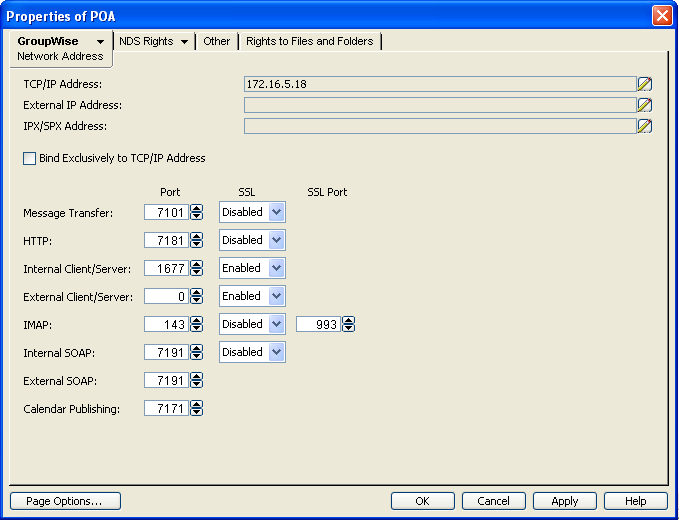
If you configured the POA for TCP/IP links during installation, the field should display the POA server’s network address. If it does not, follow the instructions in Using TCP/IP Links between the Post Office and the Domain. The POA must be configured for TCP/IP in order to provide the POA Web console.
-
Make a note of the IP address or DNS hostname in the field. You need this information to access the POA Web console.
The field displays the default port number of 7181.
-
If the default HTTP port number is already in use on the POA server, specify a unique port number.
-
Make a note of the HTTP port number. You need this information to access the POA Web console.
-
If you want to use an SSL connection for the POA Web console, which provides optimum security, select in the HTTP SSL drop-down list.
For additional instructions about using SSL connections, see Section 83.2, Server Certificates and SSL Encryption.
-
Click to save your changes on the Network Address page.
If you want to limit access to the POA Web console, or if you want to be able to change configuration settings at the POA Web console, you must provide a user name and password.
IMPORTANT:Some fields in the POA Web console are displayed only when the Web console is password protected.
-
Click , then scroll down to .

-
In the box:
-
In the field, specify a unique user name.
-
Click .
-
Type the password twice for verification.
-
Click .
Unless you are using an SSL connection, do not use a Novell eDirectory user name and password because the information passes over the non-secure connection between your Web browser and the POA.
For convenience, use the same user name and password for all agents that you plan to monitor from GroupWise Monitor. This saves you from having to provide the user name and password information as Monitor accesses each agent.
IMPORTANT:A user name and password are required in order for you to change POA configuration settings in the POA Web console.
-
-
Click to save the POA Web console settings.
ConsoleOne then notifies the POA to restart so the new settings can be put into effect.
Corresponding Startup Switches: You can also use the ‑‑httpport, ‑‑httpuser, ‑‑httppassword, and ‑‑httpssl startup switches in the POA startup file to enable and secure the POA Web console. In addition, you can use the ‑‑httprefresh switch to control how often the POA refreshes the information provided to your Web browser.
37.2.2 Accessing the POA Web Console
To monitor the POA from your Web browser, view the URL where the POA is located by supplying the network address and port number as displayed on the Network Address page in ConsoleOne. For example:
http://172.16.5.18:1677 http://172.16.5.18:7181 http://server1:7181 https://server2:1677
When viewing the POA Web console, you can specify either the client/server port or the HTTP port.
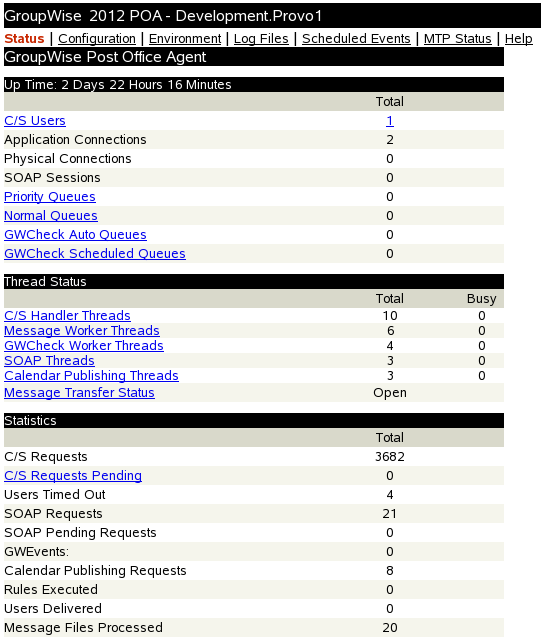
37.2.3 Monitoring the POA from the POA Web Console
The POA Web console provides several pages of information to help you monitor the performance of the POA. The title bar at the top of the POA Web console displays the name of the POA and its post office. Below the title bar appears the POA Web console menu that lists the pages of information available in the POA Web console. Online help throughout the POA Web console helps you interpret the information being displayed and use the links provided.
Monitoring POA Status
When you first access the POA Web console, the Status page is displayed. Online help on the Status page helps you interpret the status information being displayed.

Click any hyperlinked status items for additional details. The status information is much the same as that provided at the POA server console, as described in Section 37.1.1, Monitoring the POA from the POA Server Console.
Monitoring and Tracking POA Threads
The POA Status page provides links to detailed POA thread status for the following types of threads:
-
C/S handler threads
-
Message worker threads
-
GWCheck worker threads
-
SOAP threads
-
Calendar Publishing threads
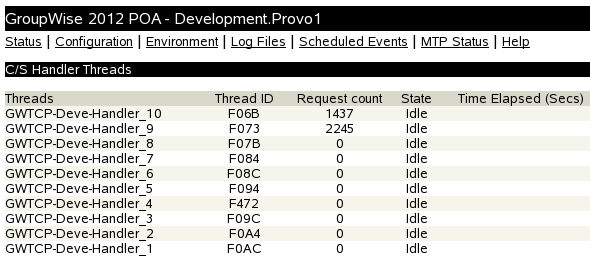
The column provides the information you need in order to track a specific thread through one or more POA log files, as described in Viewing and Searching POA Log Files.
Checking the POA Operating System Environment
On the POA Web console menu, click to display information about the operating system where the POA is running.
On a Linux server, the following information is displayed:
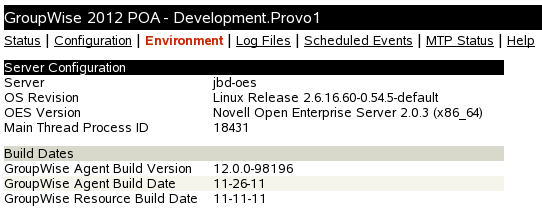
On a Windows server, the following information is displayed:
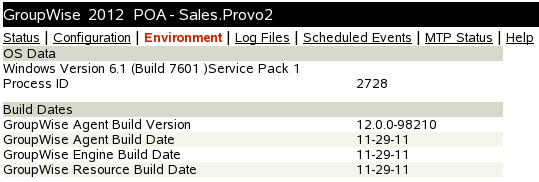
Viewing and Searching POA Log Files
On the POA Web console menu, click to display and search POA log files.

To view a particular log file, select the log file, then click .
To search all log files for a particular string, type the string in the field, select , then click . You can also manually select multiple log files to search.
The results of the search are displayed on a separate page that can be printed.
Listing POA Scheduled Events
On the POA Web console menu, click to view currently scheduled events and their status information.
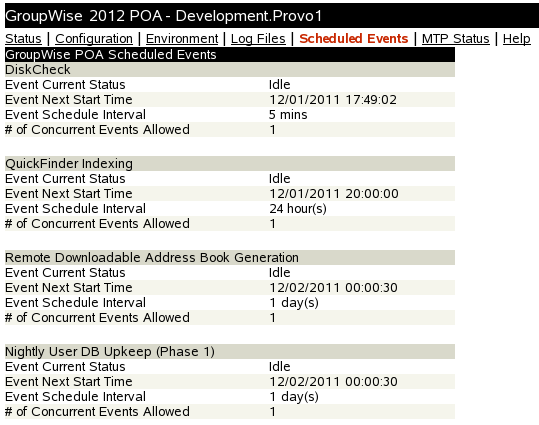
QuickFinder indexing and remote downloadable Address Book generation can be controlled using links from the Configuration page, if the POA Web console is password protected as described in Section 37.2.1, Setting Up the POA Web Console. The Configuration page also displays information about disk check events and database maintenance events. However, scheduled events must be created and modified using ConsoleOne.
Checking Link Status to the MTA
On the POA Web console menu, click to view status information about the link between the POA for the post office and MTA for the domain.
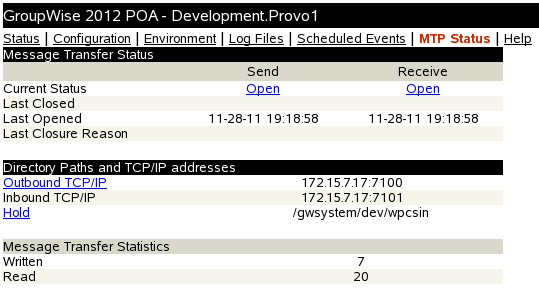
If the POA Web console is password protected as described in Section 37.2.1, Setting Up the POA Web Console, the link displays the MTA Web console where you can get status information about the MTA. The link displays the contents of the MTA input queue, so you can find out if messages are waiting for processing by the MTA.
Taking Performance Snapshots
To help you assess the efficiency of the POA, you can configure the POA to gather statistics about CPU utilization, disk reads and writes, thread usage, message processing, and so on.
-
Make sure that the POA Web console is password protected, as described in Section 37.2.1, Setting Up the POA Web Console.
-
In the POA Web console, on the Configuration page, click under the heading.

-
Select , then click .
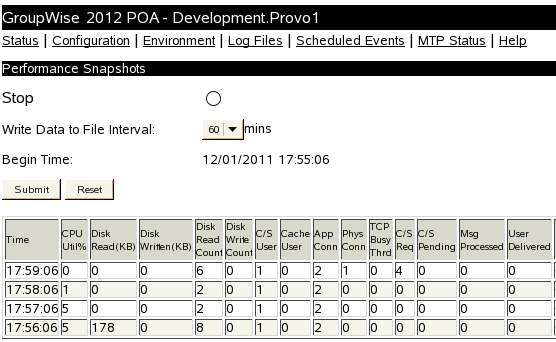
The POA takes a snapshot every 60 seconds.
-
Refresh your browser window to display data as it is collected.
-
Specify the interval at which you want to write data to a file on disk for permanent storage.
Performance data is saved to the mmddsnap.nnn file, where mmdd represents the current month and date and nnn starts with 001 and increments each time you enable performance snapshots to start gathering data. The performance data file is stored in the post_office\oftemp directory in comma-separated value (CSV) format, so that you can bring the data into a spreadsheet program for analysis.
-
When you have gathered sufficient performance data, select , then click .
Because gathering performance data uses POA resources, you should turn the feature off when you have gathered sufficient data. It is turned off automatically when you restart the POA.
-
When you are finished using performance data files, delete them to conserve disk space.
The POA does not automatically clean up old performance data files.
Monitoring SOAP Events
To help you work with third-party listener applications such as the Data Synchronizer Connector for GroupWise, the POA Web console lists SOAP notifications and SOAP events so that you can monitor the SOAP event traffic through the POA. These options are available if the POA Web console is password protected, as described in Section 37.2.1, Setting Up the POA Web Console.
Listing SOAP Notifications
The SOAP Notification List page shows the third-party listener applications that are notified by the POA when SOAP events occur.
-
On the Configuration page, click .

The columns provide the following information:
User: Displays the name of the GroupWise user that is performing the event.
Key: Displays the ID of the event configuration created by the third-party application. The event configuration describes the events that are being tracked for the user, such as creation, deletion, or modification of records.
IP Address: Displays the IP address of the POA where the event took place.
Port: Displays the port number used for communication between the POA and the listener application.
Date/Time: Displays the date and time when the event took place. An asterisk (*) after the date and time indicates that the user has pending notifications. After the notifications have been sent, the asterisk is removed.
Listing SOAP Event Configurations
The Event Configuration List page displays the event configurations that are registered to receive GroupWise events from the POA. An event configuration is listed when an external application such as the Novell Data Synchronizer Connector for GroupWise communicates with the POA and provides information about a specific type of event that it wants to receive.
For example, the Data Synchronizer Connector for Mobility works through the GroupWise Connector to synchronize GroupWise data to mobile devices. Whenever a user connects a mobile device to GroupWise through the Mobility Connector, an event configuration is created for that user and his or her mobile device. If the user has multiple mobile devices, there is an event configuration for each of the user's mobile devices.
-
On the Configuration page, click .

The columns provide the following information:
UserID: Displays the name of the GroupWise user associated with the event configuration.
Key: Displays the ID of the event configuration created by the external application. For example, the GroupWise Connector uses a GroupWise trusted application key.
IP Address: Displays the IP address of the external application that the POA notifies when events take place.
Port: Displays the port number used for communication between the POA and the external application.
Events: Displays the number of events that have transferred from the POA to the external application.
-
To manage the event configuration for a specific user, click the user name.
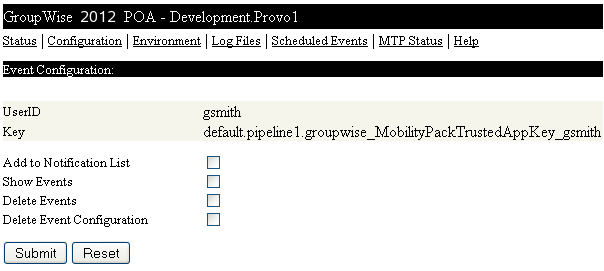
The Event Configuration page helps you manage an event configuration and the associated events that are stored in a user's database for an external application such as the Data Synchronizer Connector for GroupWise.
-
Select , then click to cause the POA to notify the external application whenever a new GroupWise event needs to be picked up.
-
Select , then click to display the currently stored events for the event configuration.
If the list is long, the external application might not be running.
-
Select , then click to delete any stored events for the event configuration.
Use this option only when a backlog of events needs to be cleared, such as when a problem occurred with the external application.
-
Click , then click to delete the displayed event configuration.
Use this option when the POA no longer needs to send events for the user associated with the event configuration. For example, if there was a problem removing a user from the GroupWise Connector, use this option to remove any residual events associated with the user.
37.2.4 Controlling the POA from the POA Web Console
At the POA Web console, you can change some POA configuration settings for the current POA session. You can also stop and start some specific POA threads.
IMPORTANT:In order to control the POA from the POA Web console, you must set up authentication for the POA Web console, as described in Section 37.2.1, Setting Up the POA Web Console.
Changing POA Configuration Settings
On the POA Web console menu, click . Online help on the Configuration page helps you interpret the configuration information being displayed.
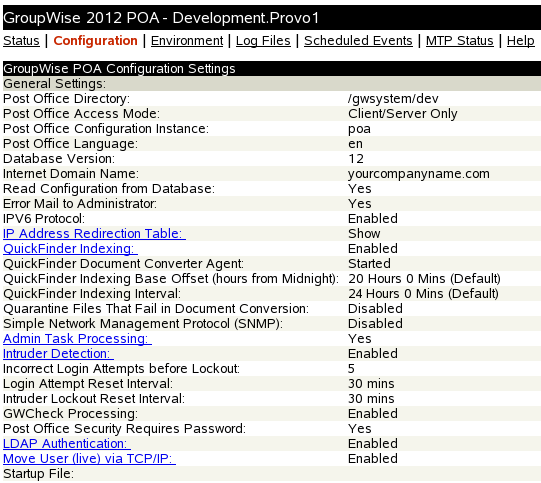
If the POA Web console is password protected as described in Section 37.2.1, Setting Up the POA Web Console, you can click hyperlinked configuration items to change settings for the current agent session. The settings that can be modified are much the same as those that can be changed at the POA server console, as described in Section 37.1.2, Controlling the POA from the POA Server Console.
Controlling the POA Admin Thread
On the Configuration page, click
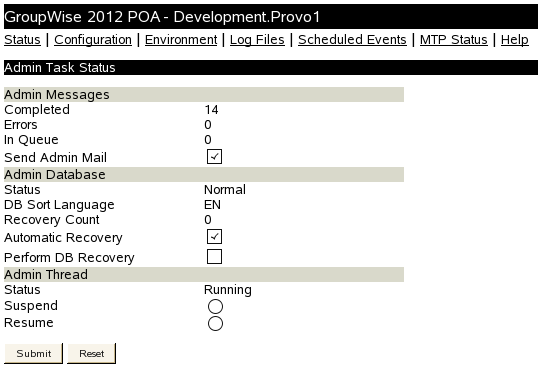
Modify the functioning of the POA admin thread as needed, then click . The changes remain in effect for the current POA session.
Controlling the POA MTP Threads
On the Configuration page, click
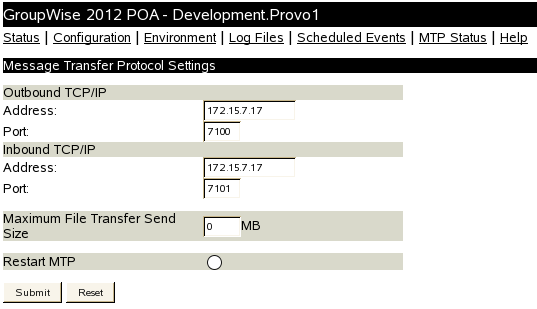
On this page, you can restart MTA processing between the POA and the MTA. On the MTP status page, you can restart the send and receive threads separately.
Disconnecting a User Session from the POA
In Online mode, the GroupWise Windows client establishes an active session with the POA. If you disable a user, as described in Section 14.9, Disabling and Enabling GroupWise Accounts while the user is logged in, it does not terminate the user’s live session with the POA. Instead of needing to restart the POA to terminate the user’s live session, you can disconnect the user in the POA Web console after disabling the user in ConsoleOne.
On the Status page in the POA Web console, click , then click for the user that you have already disabled in ConsoleOne.

IMPORTANT:When you disable the user in ConsoleOne, the POA must receive the disable event and process it before the user can be disconnected in the POA Web console. If you are running the POA server console, you can see the disable event occur in the Log Message box. When you click successfully, the user is no longer listed in the POA Web console. If the user does not disappear from the list after you click , wait for the POA to process the disable event, then click again. A disconnected user receives an error message stating that GroupWise will exit.